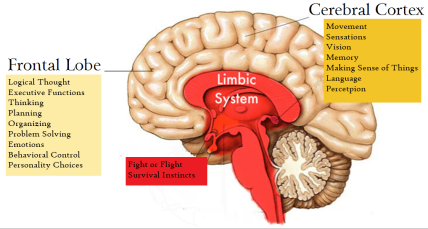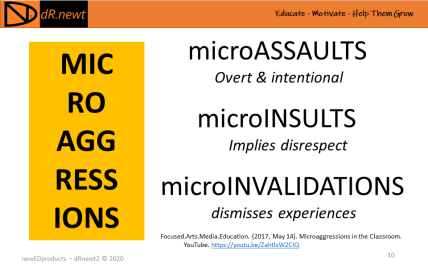
KEY 1 – Awareness
Know Thyself
Every educator has been taught to develop a sense of awareness called with-it-ness in their classroom (online and face to face). What many do not know is that the awareness that all educators need to develop should first acknowledge their own implicit biases around race, language, and ideas of traditional college etiquette, etc. (Banks, 2016).
The bitter truth is, we have all been conditioned since birth by many things like, but not limited to the songs, movies, people, resources, conversations, beliefs, images, and examples to which we have been exposed. These things have created patterns in our minds that are based on the snapshots or schema that we store in our memories as a result of those experiences. Those patterns and schema then define our norms and standard operating procedures. Such that when faced with new experiences, our reflexive reactions automatically default to our learned responses drawn from our limbic system. Unfortunately those reflexes put us in survival mode whaere we resort to either fight or flight and are unable reason logically.
Image from: https://robbwolf.com/wp-content/uploads/2015/01/limbic-brain.png
That default is what manifests as our biases. Now before you get all defensive... We ALL have biases. Having biases does not make us bad people, it makes us human.
One way that our implicit biases surface is through microaggressions. For the most part, microaggressions are unintentional and we are often unaware that we are exhibiting them. However, those to whom they are directed can see and hear them loud and clear. If educators are unaware of their implicit biases, their reflexive actions could be pushing students away, and hindering their access to mastery thus, rendering instruction less effective
The following video is 18 minutes long, and full of very valuable information, you will be able to get a handle on microaggressions after watching the first six minutes.
Focused.Arts.Media.Education. (2017, May 14). Microaggressions in the Classroom. YouTube. https://youtu.be/ZahtlxW2CIQ
Here's where you can enter in text. Feel free to edit, move, delete or add a different page element.
Prompts Which Invite
We are taught to humanize ourselves in our online classrooms. So, we share details and highlights of our lives that we have deemed pleasant (i.e. hiking, skiing, and camping trips, or precious family moments). Keep in mind these moments are amazing memories for us. However, if we serve students where the norms of their socio-economic situations do not align with the snapshots of our lives that we have shared, we run the risk of confirming in some of our students’ minds just how different we are from them. Creating a snowball effect that will become a barrier as we work toward ensuring equitable access to mastery by activating the 4 keys to creating a CRCS.
As educators we must develop an awareness of these nuances. Operating from that vantage point of heightened awareness helps us be more likely to initiate prompts that invite students to engage and feel safe enough to participate.
Humbly Ask...Then Adjust
If you are anything like me, you have made some major cultural snafus in the classroom. The consolation prize from those awkward moments are the priceless lessons we’ve learned. We were able to capitalize on the teachable moment and use it to help develop us into the powerful educators that we are today.
That being said, it is a given that as educators we must be aware of the diverse cultures in our classrooms, celebrating, embracing, and intertwining them through the thread of our course culture.
For some of us that means we will need to become familiar with the cultural tendencies of the students we are serving. The best way to increase our cultural competence is to ask questions. So humble yourself and ask questions when you notice patterns in behaviors that you may not understand, or when decisions do not seem to make sense to you, or when you can tell that the sore spot of race or cultural norms was touched. Ignoring these things does not make them go away, it only packs them away. Positioning them to resurface another day with more strength and momentum.


